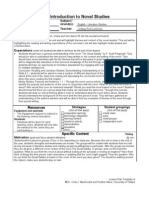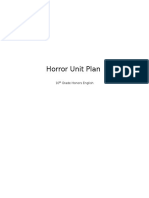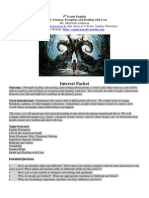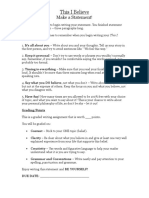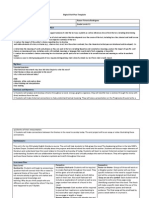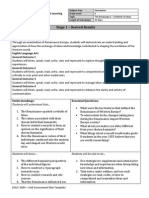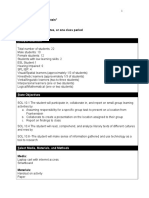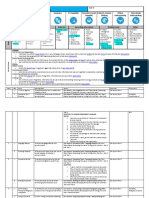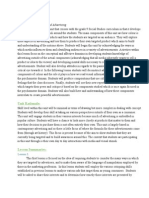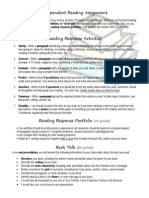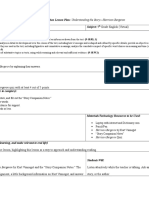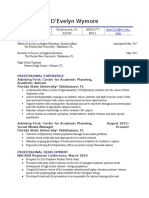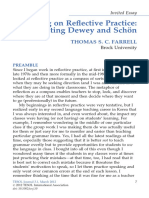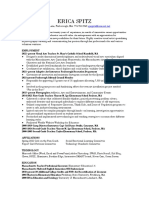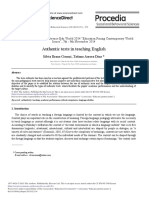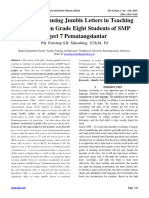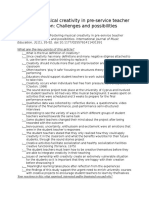Professional Documents
Culture Documents
Genre Project Unit Plan
Genre Project Unit Plan
Uploaded by
api-2422736960 ratings0% found this document useful (0 votes)
95 views45 pagesOriginal Title
genre project unit plan
Copyright
© © All Rights Reserved
Available Formats
DOCX, PDF, TXT or read online from Scribd
Share this document
Did you find this document useful?
Is this content inappropriate?
Report this DocumentCopyright:
© All Rights Reserved
Available Formats
Download as DOCX, PDF, TXT or read online from Scribd
Download as docx, pdf, or txt
0 ratings0% found this document useful (0 votes)
95 views45 pagesGenre Project Unit Plan
Genre Project Unit Plan
Uploaded by
api-242273696Copyright:
© All Rights Reserved
Available Formats
Download as DOCX, PDF, TXT or read online from Scribd
Download as docx, pdf, or txt
You are on page 1of 45
Genre Project Unit Plan 1
Genre Project Unit Plan
An In-Depth Examination of Multi-Genre Texts through Student Portfolios
DEvelyn Wymore, Chelsea Walczak, Courtney Penton
Florida State University
Genre Project Unit Plan 2
Table of Contents
Overview of Unit Plan P. 3
Day 1: Literature Circles P. 4
Day 2: Introduction to Emulating/Brainstorming P. 7
Day 3: Practicing Emulating P. 11
Day 4: Peer Reviews and Editing Emulation Writing P. 14
Day 5: Venn Diagrams for Brainstorming P. 17
Day 6: Peer Review and Editing Analytical Essay P. 20
Day 7: Sharing Portfolios P. 23
Appendix A P. 26
Appendix B P. 31
Appendix C P. 34
Appendix D P. 37
Bridging Civics and Literature: Cross-Curricular Mini Lesson P. 40
Multi-Genre Brochure P. 44
Genre Project Unit Plan 3
Overview of Unit Plan
This is a seven day unit plan covering six different multi-genre young adult novels:
Crank, Give a Boy a Gun, Perks of Being a Wallflower, The Absolutely True Diary of a Part
Time Indian, The Princess Diaries, and TTYL. This unit is designed for ninth grade students
because the text selections are not textually demanding, but the themes are too mature for
a middle school audience. Ideally, this unit would come towards the beginning of the fall
semester because the books will capture student attention and prep them for close reading
of more difficult texts.
The novels selected were chosen because they all were written in a unique style and
blend together different structural elements. Students are accustomed to reading standard,
canonized prose, but are rarely trained to read and critique literature written in poetry,
letter, pictorial, diary, or interview format. By closely examining these unique styles,
students are better equipped to determine how language, structure, point of view, and tone
are used to address different audiences and manipulate the meaning.
There are thirty students in our class and we have divided them up into six groups
of five. Each group is a literature circle and each literature circle was responsible for
reading two novels that have been paired together because of their contrasting styles, but
similar themes:
1) The Princess Diaries and TTYL
2) Give a Boy a Gun and The Absolutely True Diary of a Part Time Indian
3) Crank and Perks of Being a Wallflower.
We assigned students to these groups based on results from their interest
inventories and their reading level. As mentioned before, each student will be responsible
for handing in a portfolio at the end. This portfolio will consist of 1) a typed up creative
writing model 2) a Venn diagram and 3) A brief analytical essay. These three components
accommodate different modes of learning. Students will be meeting in their literature
circles during each of these stages because smaller groups are less intimidating and can
provide helpful peer feedback and discussion.
Genre Project Unit Plan 4
Day 1
Literature Circles
Purpose/Rationale:
It is the first day everyone has finished reading their
two books for this unit, which means it is important to give
students the opportunity to meet with their peers and
discuss reactions, observations, and questions. As
mentioned in the overview of the unit, students have been
assigned to a group of five. For this lesson, we have used
(and provided) a PDF file of five roles that can be given to
students in these circles: discussion director, literary luminary, connector, word wizard,
and illustrator/mapper. Every student was allowed to speak to us about which role they
were most interested in and prep for discussion prior to this class period. Every one of
these roles provides a really great beginning to their in-depth examination of multi-genre
as a whole. Students will spend the day weeding out some of the crucial elements in the
texts, including their connecting themes. These roles cover everything from unknown
words to text-to-world connections to locating powerful paragraphs.
Common Core Standards:
CCSS.ELA-Literacy.RL.9-10.1 Cite strong and thorough textual evidence to support
analysis of what the text says explicitly as well as inferences drawn from the text.
CCSS.ELA-Literacy.RL.9-10.5 Analyze how an author's choices concerning how to
structure a text, order events within it (e.g., parallel plots), and manipulate time
(e.g., pacing, flashbacks) create such effects as mystery, tension, or surprise.
CCSS.ELA-Literacy.SL.9-10.1.c Propel conversations by posing and responding to
questions that relate the current discussion to broader themes or larger ideas;
actively incorporate others into the discussion; and clarify, verify, or challenge ideas
and conclusions.
Objectives:
Students will be able to participate in collaborative group discussion on the two
assigned texts.
Students will be able to raise questions or key sections of the text that stood out.
Students will be able to determine the greater themes and connections between the
texts.
Materials:
Assigned books
Literature circle roles sheets
Writing Utensil
Anticipatory Set:
Genre Project Unit Plan 5
Students will listen to 1-2 minutes of the multi-genre song mix
(https://www.youtube.com/watch?v=3cCSmApTnqY) found on YouTube before meeting in
their groups. Dubstep and House music are very popular genres with todays youth so
students would be more inclined to participate in the activity. This will serve as an
introduction of the term multi-genre. After they listen to it for a few minutes, the teacher
will ask what sounds were in there that you didnt expect? How did the artist blend them
together? The answers to these questions will be lead into defining what a multi-genre
text is- which, in the simplest terms, using unexpected writing styles and, oftentimes,
mixing them together as the artist did on YouTube. Students are encouraged to provide
examples from the texts they have read to support their definitions of multi-genre.
The teacher should then ask students to pull out the worksheets with the students
roles on them while explaining instructions for the literature circles.
Teaching Strategy/Procedure/Activity:
Time Allowed Students Will Teachers Will
10 min: Anticipatory Set -listen to the music clip
-respond to questions
-make connections between
multi-genre texts and the
multi-genre song
-listen to literature circle
directions
-play YouTube clip
-ask questions mentioned in
anticipatory set
-ask students to define
multi-genre and explain
-give instructions for
literature circles
45 min: Literature Circles -meet with literature circle
groups
-make sure every student
has completed their
designated role
-use this time to really
explore these questions and
observations in depth
-walk around the room
during this time, listen in
and make sure students are
remaining focused and on
task
-guide groups that are
struggling with some of
their roles
5 min: Summary -reflect on the purpose of
these roles
-fill out self-evaluation
-ask class to think about
why this activity will help
them over the course of the
unit
-successful?
-make sure everyone hands
in their role sheet as a ticket
out the door
Summary:
The last five minutes of class are set aside to bring the class back together and ask
students to reflect on what they found beneficial about meeting in literature circles. Did
your fellow classmates introduce something you might not have thought of yourself? How
did your role contribute to the discussion? What conclusions did you come to and what
Genre Project Unit Plan 6
connections did you make between the texts? Also, students are summarizing their day by
filling out the self-reflection on their role sheets and being cognitive of what they brought
to the group today.
Assessment:
Formal- students are asked to turn in their role sheets as they exit the classroom.
These sheets will be given a full credit, completion grade so long as the student has
thoughtfully filled out all sections and self-evaluation.
Informal- asking students about the YouTube clip helps us gauge the students
understanding of genre. Also, walking around during the literature circles and
listening to how students are communicating with one another gives us an idea of
how well each student is able to collaborate with others.
Homework/Follow Up:
No homework will be due tomorrow. Students will learn what emulating is and transition
into the modelling portion of this unit.
Accommodations:
Gifted students will most likely volunteer for the discussion leader role which will
give them the opportunity to take on more work and formulate advanced questions.
ELL students are able to work in groups, where their opinions can be heard because
small groups are less intimidating. They also may take on a less language-
demanding role.
Visually impaired students will be given a large print copy of their role sheet and
books. All directions will be stated both orally and in print. We have made an effort
to place lower level readers and gifted students in groups together so they can assist
one another in the learning process.
The physically disabled student will be in an easily accessible seat in the circle. If
students finish their discussions early, more time will be given to reflect on their
roles and multi-genre.
Lower level readers will be given extra time to fill out their role sheets if necessary.
Retread students will similarly be allowed to choose the role best suited for them in
hopes they find a new way to approach something they might not have understood
last year.
ADHD students can illustrate as the group discusses. Groups with ADHD students
will also be placed in an area of the classroom with minimal distraction and they can
move to the hallway if the noise is too much.
Attachments:
Appendix A: http://www.neisd.net/roan/docs/literacy%20circle%20roles.pdf
Resources:
Going Quantum. (March 29
th
2014). GQ podcast: Multi-genre mix and flux pavilion guest mix.
[Ep. 129]. Retrieved from https://www.youtube.com/watch?v=3cCSmApTnqY.
Genre Project Unit Plan 7
Day 2
Introduction to Emulating/Brainstorming
Rationale:
While discussion of multi-genre texts provides a basis to
students understanding of the genre and style, students will become
more intimately familiar with the genre by developing their own writing
in relation to it. For this purpose, the students will be emulating the
style/genre of the two books they read for this part of the project.
Common Core:
CCSS.ELA-LITERACY.L.9-10.3 Apply knowledge of language to understand how
language functions in different contexts, to make effective choices for meaning or
style, and to comprehend more fully when reading or listening.
CCSS.ELA-LITERACY.W.9-10.5 Develop and strengthen writing as needed by
planning, revising, editing, rewriting, or trying a new approach, focusing on
addressing what is most significant for a specific purpose and audience. (Editing for
conventions should demonstrate command of Language standards 13 up to and
including grades 910 on page 55.)
Objectives:
Students will be able to recognize the distinct writing/literary features of a novel.
Students will be able to emulate the writing style/format of the novel.
Materials:
Do you want to build a snowman?
o https://www.youtube.com/watch?v=-FfScHGmk6M (3:21)
Do you want to be my boyfriend? Video: Parody of Do you want to build a
snowman? https://www.youtube.com/watch?v=bBHXK_FKP0M (2:16)
Paper and Pen/Pencil
Novel of Students choice
o The Princess Diaries or TTYL
o The Absolutely True Diary of a Part-time Indian or Give a Boy a Gun
o Perks of Being a Wallflower or Crank
Anticipatory Set:
Introduction of Emulating
To begin this class, the teacher will have the video Do you want to build a
snowman? set up on the projector (previously tested). First, the teacher should assess if
the students are aware of the song by asking students to raise their hand if they have seen
it. This will activate students background knowledge and pique their curiosity. After
showing the video, the teacher will then pull up, Do you want to be my boyfriend. Its a
funny parody of the original song, Do you want to build a snowman? and will serve as an
introduction to the concept of emulating.
Genre Project Unit Plan 8
Next, the teacher should explain, I found this version of the song on Youtube, and I
thought it was funny and creative. Id like you all to enjoy it with me, but keep in mind the
similarities and differences it has from the original Do you want to build a snowman?
song. This gives students expectations as to what they will have to get out of this
experience.
After playing the video, the teacher should start a discussion by asking How was
this video similar or different from its original? Anticipation of the students replies may
be: Its similar because it uses the same music/notes/female voice. Its different because
its not animated. Or the topic and lyrics are different.
The teacher should use these comments to guide students thinking about how
Barkada, the creator of the video, used Do you want to build a snowman? for her own
purposes. For instance, when a student comments that the topic is different, the teacher
should ask, How was the topic different? How did it suit the creators intentions?
Then lead that discussion further still by asking, Why did the creator, Barkada, use
Do you want to build a snowman? as her basis? An anticipated response may be,
Because its a popular video and will get her a lot of views.
The teacher should then talk about how many authors emulate, or imitate/copy,
popular or well-known writers. They may do this to become more popular or famous, or
maybe because they admire that writing. Many great writers start out by emulating other
writers for practice. (10-15 minutes)
Explanation of Project/Activity
Tomorrow, *the teacher should start passing out instructions, the rubric, and an
example for this project (See Appendix B)* You will be emulating an authors formatting
and style, so, today, I want you to brainstorm some topics that would best fit the format and
style of the author you are emulating. Yesterday we discussed two books in our literature
circles. Youre going to choose ONE of those books to emulate. You will be using the other
novel that you read for an essay, so choose carefully. For the emulating project tomorrow,
you will be writing your own paper or chapter or passage on any topic that you wish, but
you have to write it like the author of one of your novels.
For example, if I were emulating Romeo and Juliet (this is a reference to a book they
have previously read in the school year), then I would write my passage in the form of a
play. My topic would have to be something that didnt require a lot of description, because a
play emphasizes dialogue more than action or setting.
You can brainstorm with your group, but youll be writing your own passage as part
of your portfolio for the end of the unit. Tomorrow we will go to the computer lab to create
our passages. I encourage you to be as creative as you can! Include images, colors, and
special fontsanything that helps to emulate the authors format and style. Also, be
prepared to share your ideas at the end of class as well as your finished writing product
with your group members; we will be uploading our writing to the class blog for peer
editing!
After answering any student questions, the students should begin brainstorming
with their groups. (5 minutes)
Teaching Strategy/Procedure/Activity:
Genre Project Unit Plan 9
Time Students will: Teacher will:
15-20 Minutes: Anticipatory
Set
(See anticipatory set) (See anticipatory set)
20 Minutes: Writing Students will brainstorm
ideas for their writing
passage. They are
encouraged to create
graphic organizers, draw,
create notes, etc., to assist
them in brainstorming.
The teacher will observe
student work and provide
guidance to students who
are confused or unsure of
what to do.
*If a student cannot think of
a topic to write about, the
teacher should encourage
the student to think about
what topics suit the genre or
how the genre may serve a
particular purpose.
5-10 Minutes:
Summary/Closure
A few students will share
their topic ideas with the
class and discuss how its
similar to the book/author
they are emulating.
The teacher will ask
students or choose students
to share their ideas and
facilitate/guide their
explanations to be most
beneficial for the entire
class.
Summary/Closure:
When there is about 5-10 minutes left to the class period, the teacher should ask the
students to stop writing/discussing, and then ask students to write on a separate sheet of
paper: their name, the book and author they are emulating, and the topic they will be
addressing through that book/author.
[This is to give students a chance to reflect on their work in a general sense and also
to help the teacher prepare for the next class (because shell know what to expect them to
be working on) in which they will begin working on their writing passages.]
The teacher should also remind students to meet in the computer lab for
tomorrows class to work on the writing passages.
Assessment:
Informal: Students collaboration (discussing ideas), brainstorming techniques
(graphic organizers, drawings, notes), and their exit slips about their topics will
indicate their understanding of the assignment.
Formal: The students writing from this unit will be formally assessed at the end of
the unit.
Homework/Follow-up Assignment:
If necessary, continue working on draft ideas.
Accommodations/Adaptations:
Genre Project Unit Plan 10
The gifted and talented students are designated as group leaders within their
groups. For this lesson, they will help other students think of topics that may fit into
the format the student chooses to emulate. They are also able to express their
creativity in this open-ended lesson, which may be more advanced than other
students.
ELL students are accommodated with the help of group members and are also asked
to work on their drafts at home before and after the initial brainstorming portion of
the project.
Visually impaired students are accommodated with enlarged print of instructions
and rubrics.
The student with a physical disability will be able to participate fully in this activity.
He/she is situated at a special desk in a group, located near the door for easy
maneuvering.
Students who have difficulty reading will be able to participate because this
assignment is open-ended enough to allow students to generate their own level of
writing.
RETREAD students are encouraged to think outside of the box for their writing
responses and offer unique advice to their classmates.
Students with ADHD may be permitted to release anxiety through walking along the
back of the room or otherwise indicated by their IEP.
Attachments
Appendix B: Instructions, Rubric, and Example
Genre Project Unit Plan 11
Day 3
Practicing Emulating
Rationale:
To gain a more well-rounded writing style, students will be
emulating an author/novel. This will allow students to more deeply
understand different writing styles and their purposes. It will also allow
students to demonstrate their ability to write for a variety of purposes.
Common Core:
CCSS.ELA-LITERACY.L.9-10.3 Apply knowledge of language to understand how
language functions in different contexts, to make effective choices for meaning or
style, and to comprehend more fully when reading or listening.
CCSS.ELA-LITERACY.W.9-10.5 Develop and strengthen writing as needed by
planning, revising, editing, rewriting, or trying a new approach, focusing on
addressing what is most significant for a specific purpose and audience. (Editing for
conventions should demonstrate command of Language standards 13 up to and
including grades 910 on page 55.)
CCSS.ELA-LITERACY.W.9-10.6 Use technology, including the Internet, to produce,
publish, and update individual or shared writing products, taking advantage of
technologys capacity to link to other information and to display information flexibly
and dynamically.
Objectives:
Students will be able to recognize the distinct writing/literary features of a novel.
Students will be able to emulate the writing style/format of the novel.
Students will be able to sufficiently use technology to create a unique writing
example.
Materials:
Student notes
Computers with MS and internet access
Computer projector
Classroom blog
Book of students choice
Anticipatory Set:
Brief tutorial of computer programs
Meeting in the computer lab, the students are instructed by the teacher to log on to
the computer using their student ID/password and are informed that they are here to
work; they should not be playing games or browsing social media. The teacher should also
take this opportunity to review what the students are supposed to do. Look at your rubric
if you need to. You are writing on whatever topic you want, but you must emulate, or
imitate, the style (or way of writing) and format of the author/book you are using.
Genre Project Unit Plan 12
Then, students who are familiar with computer programs may begin to work on
their projects. However, the teacher should, using the computer projector, demonstrate for
students who do not typically use technology, a variety of tools the students may use to
create their passage. She should introduce the students to these tools, If you are not aware
of some of the basics of Microsoft Word, please pay attention up here. Im going to show
you some basics of how to make your paper creative. She should then exemplify the use of
formatting (bold, italic, font style, font color, font size) and clipart (how to insert clipart)
and move it to fit into your paper. (3-7 minutes)
Teaching Strategy/Procedure/Activity:
3-7 minutes:
Anticipatory Set
(See anticipatory set) (See anticipatory set)
40 minutes: Writing The students will write/create
their passage which emulates
the book/author of their choice
using their own topic.
They will continuously save the
document to their student
account.
When they are finished with
their writing, they will upload
the finished document to the
classroom blog.
The teacher should take
attendance as they are working.
She will monitor the students
and provide advice and answers
to students who are confused or
stuck.
The teacher will remind
students, intermittently, to save
their work to their student
account.
The teacher will write the class
blog address at the front of the
room.
The teacher will give a ten
minute warning to students to
wrap up their writing and
upload the document to the
classroom blog to be edited
tomorrow. She should also
advise the students that it
doesnt have to be perfect; it is a
rough draft that they will revise
and edit tomorrow.
2-3 minutes:
Summary/Closure
(See summary) (See summary)
Summary/Closure:
The teacher should ask the students to exit out of the programs and log off the
computer. As they are doing that, the teacher should ask students any
difficulties/challenges they had with emulating another writer. This is for the teacher to
gain insight to any problems with the lesson as well as for students to explain any choices
they had to make for the project due to problems.
Genre Project Unit Plan 13
The teacher should remind students that they will be meeting in the computer lab
again tomorrow to peer-review and edit their writing.
Assessment:
Informal Assessment: The productiveness of the students/ their ability to stay on-
task while creating their writing will demonstrate students ability to create a piece
of unique writing. Also, students willingness to share their difficulties/experiences
with the project will indicate their responsiveness to the project.
Formal Assessment: The writing produced will be graded at the end of the unit
according to the rubric provided.
Homework/Follow-up Assignment:
If necessary/possible, the students may continue working on the writing passage at
home.
Students will be asked to write about how their topic is best presented using the
format and style (book/author) they chose to turn in at the beginning of the next
class. [This is to have students critically examine their work and to prepare them for
the reviewing/editing process for the next class.]
Accommodations:
The gifted and talented students are able to express their creativity in this open-
ended lesson, which may be more advanced than other students.
ELL students are asked to work on their drafts at home before and after the initial
drafting process of the project.
Visually impaired students are accommodated with enlarged (zoom) displays for
their work.
The student with a physical disability will be able to participate fully in this activity.
He/she is situated at a special desk accessible for wheelchairs within the computer
lab.
Students who have difficulty reading will be able to participate because this
assignment is open-ended enough to allow students to generate their own level of
writing.
RETREAD students are encouraged to think outside of the box for their writing
responses.
Students with ADHD may be permitted to release anxiety through walking along the
back of the room or otherwise indicated by their IEP.
Genre Project Unit Plan 14
Day 4
Peer-Reviews and Editing Emulation Writing
Rationale:
The review process enables students to become
critics of writing by forcing them to evaluate their peers
and make suggestions for improvement. It also makes
students accept critiques and possible explain their artistic
choices.
The editing process enables students to critically re-
examine their work and improve it, just as they might have
to in college or for any writing they wish to see published.
Common Core:
CCSS.ELA-LITERACY.W.9-10.5 Develop and strengthen writing as needed by
planning, revising, editing, rewriting, or trying a new approach, focusing on
addressing what is most significant for a specific purpose and audience. (Editing for
conventions should demonstrate command of Language standards 13 up to and
including grades 910 on page 55.)
CCSS.ELA-LITERACY.W.9-10.6 Use technology, including the Internet, to produce,
publish, and update individual or shared writing products, taking advantage of
technologys capacity to link to other information and to display information flexibly
and dynamically.
Objectives:
Students will be able to critically examine a peers writing and provide constructive
feedback.
Students will be able to accept critiques and make necessary edits to their own
writing to better suit the purpose of the writing.
Materials:
Computers/MS and internet access
Classroom blog
Anticipatory Set:
As the students come into the classroom, the teacher will collect students
homework and tell the students to log onto their students accounts using their
username/password and to go to the classroom blog (written on the board at the front of
the room), reminding them again that they are here to work and should not be playing
games or on social media websites.
To start the class the teacher will explain, You will be peer-reviewing each others
work today. You will click on one of your group members documents, *The teacher should
demonstrate this at the front of the classroom* then you will download the document by
double clicking it in order to read it. Although you can edit the document with the Track
Genre Project Unit Plan 15
Changes feature on Microsoft Word, I want you, after you have read through it, to put your
comments on the Blog so that we can all view them.
The teacher should then set perimeters for the peer-review process. I would like
you to use the rubric that I handed out on Tuesday to guide how you are critiquing the
writing. You need to review at least two of your classmates writing passages, saying at
least one thing they did well and at least two things you think they can improve on.
Your comments need to be specific. Remember we want dollar-comments
(reference to something they have previously discussed) which are specific and helpful to
your peers, not penny-comments which are vague and unhelpful.
You will have 20 minutes to peer-review at least two of your classmates writing
samples. If you finish before I call time, you should review a third.
After the twenty minutes are complete, you will return to your own blogs and
review the comments of your classmates said about your writing. You should use those
comments to edit and improve your writing sample.
After answering any questions, the students may begin peer-reviewing.
Teaching Strategy/Procedure/Activity:
2-3 minutes:
Anticipatory Set
(See anticipatory set) (See anticipatory set)
20 minutes: Peer-
review Process
Students will download another
peers writing passage, read
and evaluate it using the rubric
for the writing, then comment
on his/her blog with one
compliment and two critiques.
The teacher will monitor student
work, complimenting students on
good comments, or pushing
students to think more deeply
about the writing when the
comments are lacking.
The teacher will also give a half-
way warning, urging students to
be working on their second
critique and a 5 minute warning to
wrap-up their comments.
20 minutes: Editing
Process
Students will use comments
and critiques by peers to
enhance/edit their writing.
Students will submit their
reviewed/edited document to
the classroom blog again, titling
the blog post Last name:
Revised Emulation of [Title of
Work]
Teacher will monitor students
work, adding additional support or
suggestions for improvement if a
student is unsure what to do.
Teacher will ask the student to re-
submit/upload the finished
document in a new blog post as
Their last name: Revised
Emulation of [Title of Work]
If a student finishes early, the
teacher should ask the student to
explain any changes he/she made.
2-3 minutes:
Summary/Closure
Students will re-submit their
final drafts (exception: ELLs)
and exit out of the programs,
Teacher will tell the students to
submit their final draft to the class
blog, exit out of the programs, and
Genre Project Unit Plan 16
then log off the computer. log off of the computer.
Summary/Closure:
As the students are logging off of the computer, the teacher should ask the class,
What are the benefits of peer comments? How did it help you revise your original draft?
This is to allow the students an opportunity to reflect on the purpose of the revision
process and the progress they made with their writing today.
Assessment:
Informal: Students ability to keep on task accentuates their understanding of the
revising and editing process. Also, their comments will be reviewed for
contribution/completion to show that they understood the process of peer-editing.
Formal: The students writing will be formally assessed by the rubric provided for
the final portfolio at the end of the unit.
Homework/Follow-up Assignment:
Students may continue to edit their writing. They are encouraged to ask their
parents, teachers, and fellow peers for more feedback than provided in class. If they
do this, they must resubmit their final copy to the class blog by the next class.
Students are also asked to print out their final copy and bring it to class the next day.
Accommodations:
The gifted and talented students are able to help lower students by providing more
helpful/detailed comments/critiques.
ELL students are asked to work on their drafts at home before and after the initial
drafting process of the project.
Visually impaired students are accommodated with enlarged (zoom) displays for
their work.
The student with a physical disability will be able to participate fully in this activity.
He/she is situated at a special desk accessible for wheelchairs within the computer
lab.
Students who have difficulty reading will be able to participate because student
writing does not high-level reading.
RETREAD students are encouraged to provide comments that relate to their
experiences with doing writing assignments.
Students with ADHD may be permitted to release anxiety through walking along the
back of the room or otherwise indicated by their IEP.
Genre Project Unit Plan 17
A
C B
Day 5
Venn Diagrams for Brainstorming
Purpose/rationale:
The purpose of this lesson is to encourage students to think
critically about the two texts they have read in order for them to make
connections between the two. This lesson will allow the students to
think about each text separately, as well as giving them the
opportunity to find similarities between the two texts. It is
important to do this activity within this unit because it is
important for students to be able to make connections between
different texts, especially when they initially seem very different.
Common Core Standards:
CCSS.ELA-Literacy.W.9-10.2 Write informative/explanatory texts to examine and
convey complex ideas, concepts, and information clearly and accurately through the
effective selection, organization, and analysis of content.
CCSS.ELA-Literacy.W.9-10.4 Produce clear and coherent writing in which the
development, organization, and style are appropriate to task, purpose, and
audience.
Objectives:
Students will be able to arrange similarities and differences between the two texts
into a Venn diagram.
Students will be able to compare and contrast the two texts by displaying the
similarities and differences on a Venn diagram
Materials:
Writing utensils
Handout of Venn diagram to fill in
Blank paper
Anticipatory set:
The teacher will begin the lesson briefly reviewing what a Venn diagram is and why
it is used (to display similarities and differences between two or more works). The teacher
will pass out an example Venn diagram modeling what is expected from them, and a blank
one for the students to fill in during their group time. The teacher will then ask the students
to fill in the Venn diagram in their groups, comparing and contrasting the two texts that
they read. The Venn diagram is worth 30 points in their portfolio for the unit. The students
will need at least five details in each section. Once they have completed the Venn diagram,
they will pass them to the front of the classroom for grading.
Teaching Strategy/Procedure/Activity:
Time Student is doing Teacher is doing
Genre Project Unit Plan 18
5 minutes: Anticipatory
Set (See above)
Listening to instructions.
Taking out writing
utensils and asking any
questions they may have.
Explaining the activity and
answering any questions.
20 minutes: Venn diagram
activity
Filling out the Venn
diagram
comparing/contrasting
the two texts.
Observing and answering
any questions.
7 minutes: Explaining
paper
Listening and asking
questions.
Explaining paper activity.
She will also pass out the
rubric and example of the
paper (Appendix D).
Students will need to
write a 500 word paper
on ONE of the texts that
they read. In the paper
they will need to discuss
how the text being written
in Multi Genre format
affects the conflicts and
overall message of the
text. Whichever book that
they used for their
modeling activity, they
must use the other book
for this activity. The
student must properly cite
and demonstrate MLA
format in their essay. The
paper will be worth 40
points in their portfolio.
16 minutes:
Brainstorming activity
Thinking about, planning,
and beginning the rough
draft of their paper.
Observing and answering
any questions.
2 minutes: Closure
(See below)
Listening and asking
questions.
Answering questions.
Summary/Closure:
The class will end with the teacher briefly summarizing the activities. The students
will keep what they have started on their paper and will continue working on it later. The
teacher will answer any questions the students have about the paper or the Venn diagrams.
Assessment:
Genre Project Unit Plan 19
Formal assessment: Venn diagrams. Students will be graded on demonstrated
understanding of the texts and whether they were able to put at least five details in
each area.
Informal assessment: Understanding will be monitored by completion of the tasks
and participation.
Homework/follow-up assignment:
Students will need to write the rough draft of their paper to be use on Monday for peer-
review.
Accommodations/adaptations:
Students receiving special education instruction will be provided with the following
accommodations: preferential seating, check for understanding, extended time.
Written instructions will be provided, as well as large print instructions for those
with visual impairments.
A voice amplification system as well as one-on-one instructor will be provided to
those with hearing disabilities.
For English Language Learning students I will provide assistance with translations
and cue words, as well as providing them with a dictionary that translated their L1
to English.
Since the activities require the students to map out their ideas, ADHD students
should be able to stay on task.
Students will physical disabilities (such as being paralyzed) will need no special
accommodations for this activity since it will take place at the students desks.
A student who is repeating the grade level will need no special accommodations for
this activity.
Students who read below reading level will need no special accommodations for this
activity.
Gifted and Talented students can be accommodated by having them help the ELL
students if they are struggling with translating any of their thoughts into writing.
Attachments/Appendices:
Appendix C: Venn diagram example, Venn diagram worksheet, Rubric for Venn diagram
Appendix D: Analytical Essay Rubric and Example
Genre Project Unit Plan 20
Day 6
Peer-Review and Editing Analytical Essay
Zweck:
The review process enables students to become critics of writing by
forcing them to evaluate their peers and make suggestions for
improvement. It also makes students accept critiques and clarify parts in
their writing that may appear confusing to others.
The editing process enables students to critically re-examine
their work and improve it using the advice given during the review
process, just as they might have to in college or for any writing they
wish to see published.
Common Core Standards:
CCSS.ELA-LITERACY.W.9-10.5 Develop and strengthen writing as needed by
planning, revising, editing, rewriting, or trying a new approach, focusing on
addressing what is most significant for a specific purpose and audience. (Editing for
conventions should demonstrate command of Language standards 13 up to and
including grades 910 on page 55.)
Objectives:
Students will be able to critically examine a peers writing and provide constructive
feedback.
Students will be able to accept critiques and make necessary edits to their own
writing to better suit the purpose of the writing.
Materials:
Example Essay and Overhead Projector
Essays
Writing Utensils
Anticipatory Set:
The teacher should open the class by reminding the students of the work they have
completed last week and the purpose of their work. Last week, you discussed the two
novels you read in your groups, then emulated one of the novels you read, before finally
creating a Venn Diagram together to compare and contrast the two novels. All these
activities were aimed to make you think critically about the novel you read. Those thoughts
should show in the paper you wrote for todays class.
The teacher should then ask the students to pull out their rough drafts, rubrics, and
example essay. To jumpstart the students reviewing and editing mindset, the teacher will
model the review process using the example essay. She should ask a student to read the
essay aloud. As the student reads, the teacher will mark parts of it using the overhead; she
should make sure to leave a mix of remarks (based on the types of remarks seen during the
Genre Project Unit Plan 21
last online review session). After the essay has been read through, the teacher should ask
the students what they think of her review marksare they thorough or too short? Are
there good AND critical remarks? Are the remarks in any way rude? To wrap up the
introduction, the teacher should then remind students of good reviewing practices as they
review each others work. They have 20 minutes to review and 20 minutes to edit their
own. Use your time wisely. This essay is worth 40 points in your portfolio!
Teaching Strategy/Procedure/Activity:
Time Student is doing Teacher is doing
5-7 minutes: Anticipatory
Set
Actively engaged in the
review
Modeling the review process
for students
20 minutes: Review Process Students are practicing good
review practices by
constructively criticizing and
praising their peers work.
Teacher is observing the
review processes and giving
advice to students on their
papers.
20 minutes: Editing Process Students are editing their
papers using the
comments/critiques of their
peers.
Teacher is observing the
editing process and giving
advice to students on their
papers.
3-5 minutes: Summary
Summary:
As the class period draws to a close, the teacher should ask students to wrap up
their work. Then, the teacher should remind students that their portfolios are due at the
beginning of class tomorrow including their Emulation writing, Venn diagram, and
Analytical Paper. They should be prepared to present their best work and explain why it is
their best.
Assessment:
Informal assessment: students active participation in the review and editing
process
Formal assessment: Quality of work on their analytical paper
Homework/follow-up assignment:
Students should polish their analytical paper and type and print it for their portfolio.
Accommodations:
The gifted and talented students are able to help lower students by providing more
helpful/detailed comments/critiques.
ELL students are asked to work on their drafts at home before and after the initial
drafting process of the project.
Visually impaired students will have the peers papers read aloud to them to
critique.
Genre Project Unit Plan 22
The student with a physical disability will be able to participate fully in this activity.
He/she is situated at a special desk accessible for wheelchairs within the computer
lab.
Students who have difficulty reading will be able to participate because student
writing does not high-level reading.
RETREAD students are encouraged to provide comments that relate to their
experiences with doing writing assignments.
Students with ADHD may be permitted to release anxiety through walking along the
back of the room or otherwise indicated by their IEP.
Genre Project Unit Plan 23
Day 7
Sharing Portfolios
Zweck:
It is the final day of the multi-genre unit and students have
successfully completed a literature circle discussion and all three
components of their portfolio. One of the main points of a
portfolio is to allow students to show their growth and progress
of understanding and include the work of which they are most
proud. While students didnt have much of a choice as to what to put
in the portfolio, they will be able to choose which work they either
enjoyed making the most, learned the most from, or are the most proud of and
present it to the class today. Each student will be given 1-2 minutes to show the class their
work using the projector. This activity is a nice way to summarize the entire unit, teach the
class something about all the texts, and show the class the many ways students approached
the assignments.
Common Core Standards:
CCSS.ELA-Literacy.SL.9-10.4 Present information, findings, and supporting evidence
clearly, concisely, and logically such that listeners can follow the line of reasoning
and the organization, development, substance, and style are appropriate to purpose,
audience, and task.
CCSS.ELA-Literacy.RL.9-10.10 By the end of grade 10, read and comprehend
literature, including stories, dramas, and poems, at the high end of the grades 9-10
text complexity band independently and proficiently.
CCSS.ELA-Literacy.W.9-10.9 Draw evidence from literary or informational texts to
support analysis, reflection, and research.
Objectives:
Students will be able to present work of choice to the class.
Students will be able to articulate why choice was made- Best work? Most learned?
Students will be able to listen to other classmates findings and interpretations.
Materials:
Portfolios
Projector
Anticipatory Set:
Due to the fact that this is the last day in the unit, nothing new needs to be explained
or taught to students, so the first few minutes of class will simply be spent telling them how
the presentations will be conducted. Attendance will be taken as students come up to
present.
Teaching Strategy/Procedure/Activity:
Genre Project Unit Plan 24
Time Allowed Students Will Teachers Will
2 min: explanation -listen to teachers
instructions
-instruct students as to how
the presentations will be
conducted (bring up your
best work, put it under the
projector, and discuss why
you chose that piece)
48 min: presentations and
hand in portfolio
-alternate by rows coming
up to the front and
presenting
-hand in portfolios
-take attendance as
students come up and grade
presentations
-ask questions when
needed
-collect portfolios
Summary:
Presentations provide a summary within themselves, allowing students to learn a
bit about all the multi-genre texts without having to read all of them. After this unit comes
to a close, students will be moving on to canonical texts and using their same close reading
strategies to examine the characters, themes, structure, and styles of the more advanced
works.
Assessment:
Formal- Students will turn in their portfolio assignments and each one will be
graded according to its given rubric. Modelling equals 30 points, Venn diagram
equals 30 points, and the essay equals 40 points, for a total of 100 possible points.
The presentation itself is just for the sake of teaching the class and will not be
graded.
Informal- Students are not being graded according to how well they speak, but it is
important to keep notes on how well students are able to concisely present
information to a class, articulate points, and maintain generally nice speaking
etiquette (eye contact, volume etc.). If students seem to be struggling with this, it
would be helpful to include a mini lesson on speaking skills.
Homework/Follow Up:
None.
Accommodations:
Visually impaired students will be seated at the front of the classroom so they are
close to the projector. Also, the projector will be zoomed in so as to optimize clear
vision of it.
ADHD students will be seated next to the teacher during presentations so they avoid
disrupting others by starting side conversation. Standing up for their presentation
will help rid some of the energy.
Physically disabled students will be seated at an easily accessible desk right next of
the projector so they do not have to spend time maneuvering their way to it.
Genre Project Unit Plan 25
Presentations give leeway for students to include whatever information they see
best fit, so gifted students can really make their allotted time as in-depth and
detailed as they would like.
Lower level readers and ELL students might be embarrassed to show one of their
works up on the projector, so they will be given the option to hold it and just talk
about it instead.
If presentations are very successful and students are using more than a few minutes
each, then these will flow into tomorrow and the canonized texts will be pushed
back because these presentations are really valuable.
Unit Resources:
Alexie, S. (2007). The absolutely true diary of a part-time indian. New York: Little, Brown
and Company.
Cabot, M. (2000). The princess diaries. New York: Harper Collins Publishers.
Chbosky, S. (1999). The perks of being a wallflower. New York: Pocket Books.
Hopkins, E. (2004). Crank. New York; Simon Pulse.
Myracle, L. (2004). Ttyl. New York: Amulet Books.
Strasser, T. (2000) Give a boy a gun. New York: Simon Pulse.
Genre Project Unit Plan 26
Appendix A
Genre Project Unit Plan 27
Genre Project Unit Plan 28
Genre Project Unit Plan 29
Genre Project Unit Plan 30
Genre Project Unit Plan 31
Appendix B
Instructions for Emulating Project
The Project
The main objective of this project will be to emulate, or imitate, an authors
formatting and style. You will produce a piece of writingit can be as long as you feel it
needs to be, but needs to be long enough to show your ability to emulatein which you use
the authors formatting and style for your own purpose.
Example: Im emulating Romeo and Juliet. The format is a play and the style is that of poetry/iambic
parameter, so I will write my passage in the form of a play with that style. My topic has to be
something that doesnt require a lot of description, because a play emphasizes dialogue more than
action or setting, and probably something sentimental or romantic because of the verse. For this
reason, Im writing my play scene about a father and daughter just before she leaves for college.
This allows me to be sentimental in a different way than Shakespeare, discuss an important
moment in my life, and I can use a more modern language while retaining the poetry of his play.
Tidbits
Be as creative as you want to suit the style of the writing you are emulating!
You will be graded by the rubric provided. Use this as a guide if you are stuck.
This project is worth 30% (30 points) of your overall grade for the portfolio project
in this unit.
Timeline
Day One:
Choose one of the novels/authors from the two that you have previously read and
discussed with your group
Brainstorm Ideas/Topics for your writing passage
Day Two:
Write your writing passage based on the format and style of the novel you chose
Submit your writing passage rough draft to the classroom blog
Day Three:
Peer-review two other students writing passages
o Write in the comments of their blogs one thing they did well
o Write in the comments of their blogs two things they can improve on
Genre Project Unit Plan 32
Rubric for Emulating Project
Objectives Points Comments
Student uses the format and style of the book he/she
chose to emulate.
/10
Students chosen topic is clearly defined within the
format and style for the book he/she chose to emulate.
/10
The student fully participated in the writing process:
brainstorming, writing, reviewing, and editing.
(Based on teacher observation and student homework
and participation.)
/10
Total:
/30
Genre Project Unit Plan 33
Emulating Example of The Princess Diaries
Name: ____________________ Date: ________
August 18
th
, 2007
Monday Bus Ride
Dear Diary,
Today was the first day of high school. I woke up with nervous energy bubbling
in my stomach. It was like Yosemite moved locations and decided my organs
made for a nice hot springs. Every few minutes I could feel the excitement and
nervousness rising in my throat, urging me to do something like scream
hysterically to release it. I chose to wake up to Good Morning Baltimore from
the Hairspray soundtrack (dont judge me and my love of cheesy musicals)
because its peppy, 60s style beat was sure to have me waking up on the right
side of the bed. Oh, oh, oh woke up today, feeling the way, I always do! Oh, oh,
oh hungry for something that I cant eat, then I hear that beat! Ok, so the
second part of those lyrics is definitely true because I cant even look at a donut
without gaining weight, but the first part was not so true. I felt different. Very
different. I knew that this could be the year when I redefine myself. Ha! No one
would look at me like Im some untouchable species from a foreign planet and
no one would giggle in their close knit groups in the lunch room as I awkwardly
stumble in looking for a seat. Today was the first day of many that I would
march into Heritage like I owned the place and be overwhelmed by the number
of waves I received strutting my stuff down the hallway. Well, much to your
surprise (hey, act surprised will you), this isnt how it turned out. Much to my
dismay, my day was not as special as any other. In fact, you could put it right
up there with the awkwardness of middle school. I fumbled with my locker code
and, after 20 minutes of failure, had to ask an upperclassman to oh so
graciously help me out. I got lost looking for my cardio class when I realized
our school has three gyms (seriously, who needs three gyms?), and I had made
no new friends by lunch. I can only hope that
TOMORROW is the day when everything gets redefined
because today was certainly a dud.
Until Next Time,
Chelsea <3 <3 <3
Homework: pg. 20 #1-20, read chp 1-5 of Romeo and Juliet
Genre Project Unit Plan 34
Appendix C
Group 2: Give a Boy a Gun and The Absolutely True Diary of a Part Time Indian
Venn Diagram Example
Name: ____________________________ Date: __________________
THEMES/MOTIFS:
VIOLENCE, LOSS, SADNESS,
CONFLICT, YOUTH, IGNORANCE,
BLURRED LINE BETWEEN
RIGHT/WRONG,
ELICITING A STRONG EMOTIONAL
RESPONSE FROM THE READER
RESEARCHED AND ACCURATE
PORTRAYAL
SOCIAL CHANGE PROPOGANDA:
REVEALING SWEPT UNDER THE
RUG PROBLEMS OF SOCIETY
COMBINES MULTIPLE STYLES TO
ENHANCE THEMATIC OR
CHARACTER DEVELOPMENT
Give a Boy a Gun
STYLE:
INTERVIEWS OF MEMORIES AND
RECOLLECTIONS, FACTS,
STATISTICS, NEWS
-INCLUDING REAL LIFE NUMBERS
AMONGST FICTIONAL INTERVIEWS
MAKES IT HIT CLOSE TO HOME,
REMOVES YOU FROM THE
FANTASY WORLD AND REMINDS
YOU OF STUDENTS LOST TO
COMMUNITY (LITTLETON)
POV:
ANONYMOUS REPORTER
-MORE IMPERSONAL
MAIN TOPIC:
GUN VIOLENCE AND SCHOOL
SHOOTINGS
The Absolutely True Diary of a Part
Time Indian
STYLE:
DIARY, ILLUSTRATIONS
POV:
TEENAGE BOY, JUNIOR
-CHILDISH, BUT OBSERVANT
-HUMOROUS TONE HELPS
ALLEVIATE OVERWHELMING, GRIEF
STRICKEN SITUATION
-EASY TO SYMPATHIZE WITH
MAIN TOPIC:
LIFE ON AN INDIAN RESERVATION,
INEQUALITY, AND CONFLICT WITH
IDENTITY
Genre Project Unit Plan 35
Venn Diagram
Name: _________________________ Date: _________________
Genre Project Unit Plan 36
Rubric for Venn Diagram
Objective Points Comments
Student showed understanding of the Venn Diagram through
logical points comparing and contrasting the novels chosen.
/10
Student listed a minumum of 5 points in each section of the Venn
Diagram.
/10
Student worked with their group, contributing ideas and
supporting or refuting ideas.
(Based on teacher observation of group work.)
/10
Total:
/30
Genre Project Unit Plan 37
Appendix D
Name: _______________________ Date: ___________
Essay Example
The Perks of Being a Wallflower
The Perks of Being a Wallflower is written in diary format. This provides a very
unique perspective into Charlies life because it allows us to see all of his thoughts on
everything he is experiencing, rather than seeing it from someone elses point of view.
Usually in all the books we read we are just reading about someones life from the outside
looking in, but in this book we got to experience all of Charlies feelings first-hand. This is a
neat trait for a book to have because it allows us to connect to the main character on a
much more personal level by giving us access to every intimate thought. It is also neat to
read this text in diary format because it isnt in a usual diary format where someone writes
an entry every day. Charlie writes his entries sporadically and sometimes there are several
weeks in between entries, which is another detail that makes this book interesting. By only
writing randomly, it only exposes us to events that Charlie finds really important,
memorable, or influential. This provides insight into the more intimate side of Charlie
because it allows us to see the moments that are the most important to him, rather than
just a stream of consciousness diary.
This is useful for us to understand the overall message of the text, because
ultimately it is about how Charlie is indeed a wallflower. This novel being written in diary
format allows us to see why Charlie is quiet and shy and why he feels the way he does. The
Genre Project Unit Plan 38
sexual abuse he suffered from his aunt has ultimately forced him to become a tortured soul
who is depressed and who greatly depends on other people for his happiness. When his
friends stop talking to him because he kissed Sam at the party instead of Mary Elizabeth, it
causes Charlie to plunge into a deep depression. We get to experience this first-hand,
allowing us to truly see Charlies feelings throughout all of this. It is good that this text is
written in diary format because it allows the reader to connect to the main character on a
deeper level because there are many of us who could be experiencing some of the same
things in their lives. Its great that we are able to read about these things in diary form
because it helps us to realize that we are more alike than we think we are and we are all
facing some sort of battle in our lives. This novel being written in diary format affects the
conflicts and overall message of the novel by giving the reader a very one-sided, but very
personal view, into events occurring in Charlies life. The overall message of the text is that
while we may feel alone and that We accept the love we think we deserve (Chbosky, 24),
we are not alone. We must learn to love ourselves and we will be okay. This book being
written in diary form takes us on the personal journey of Charlie learning to love himself
and finally becoming happy.
Works Cited
Chbosky, Stephen. The Perks of Being a Wallflower. MTV Books/Pocket Books, 1999. Print.
Genre Project Unit Plan 39
Rubric for Analytical Essay
Objectives Points Comments
Student used quotes and/or details from novel to
support their thesis.
/15
Student made a clear analysis of the style and
format of the literary work that they read in
relation to the topics addressed in the novel.
/15
Student used proper grammar and language
conventions throughout the paper. Student used
MLA properly when citing and referencing outside
sources.
/10
Total
/40
Genre Project Unit Plan 40
Bridging Civics and Literature: Cross-Curricular Mini Lesson
Zweck:
As a literacy advocate in the school, it is important for us to reach out and connect ideas from our
English classrooms to other subject areas. While our students are engaging with multigenre texts,
they will also be studying American Government and Civics in their Social Studies class. This
topic primarily deals with laws, policies, political parties, and the organization of governmental
branches. There are thousands of articles that have been written on these topics because the US
has parties of people with differing opinions on how the nation should be run. People rely
heavily on argument and persuasion when writing about these topics. So how does this tie back
to multigenre? Well, the overall theme of our unit is to get students thinking about how the way
something is written effects a readers interpretation and understanding. An author that chooses
to use instant messaging is trying to portray a much different message than an author using
primarily statistics and interviews. Just as authors are aware of the audience they are writing for,
so are people publishing opinionated articles about the government. For this mini lesson, our
students will examine two sources written about Obamacare with contrasting opinions. They will
then be asked to discuss with the class which article they found to be more effective/persuasive
and what devices were similar/different between the authors (structure, ethos, logos, pathos etc.).
Common Core Standards
CCSS.ELA-Literacy.RI.9-10.3 Analyze how the author unfolds an analysis or
series of ideas or events, including the order in
which the points are made, how they are
introduced and developed, and the connections
that are drawn between them.
CCSS.ELA-Literacy.RI.9-10.6 Determine an authors point of view or purpose
in a text and analyze how an author uses
rhetoric to advance that point of view or
purpose.
CCSS.ELA-Literacy.RH.9-10.6 Compare the point of view of two or more
authors for how they treat the same or similar
topics, including which details they include
and emphasize in their respective accounts.
Objectives:
SWBAT
Determine some of the key features of an argument.
Genre Project Unit Plan 41
Compare and contrast the point of view of the two authors on Obamacare.
Establish what specific choices were made by each author to express their view.
Materials:
Two Articles
Paper and Pen/Highlighters
Computer and Projector
Anticipatory Set:
Students will be shown a short segment of the 2012 presidential debate between Obama and
Romney (https://www.youtube.com/watch?v=dkrwUU_YApE). This video functions in a few
ways: it is a verbal example of what they will be encountering within the two articles, its an
event many of them will be familiar with and can draw connections to as they read, and it
combines the elements of social studies topics with the elements and speech and rhetoric of
English. Before students begin watching this, we will make sure to tell them that is a prelude to
their article activity so they watch it with a close eye and start activating knowledge. While they
are watching the clip, we will be taking attendance and making sure every student has a copy of
both articles.
Tick Tock:
Time Allowed Students Will Teachers Will
5 min:
introduction
video,
reflection, and
explanation
-Listen to teachers
reasoning for the video
-Silently watch clip, take out
piece of paper if needed for
note taking
-Volunteer to answer
question
-Listen to teachers
explanation of the article
activity
-Tell students the video is leading into an
activity involving two, contrasting ethics
articles
-Play clip for 3 min, take attendance and
hand out articles while students are
watching
-After finishing the 3 min video segment
students will be asked to raise their hand
and point out an observation they made
about the two mens debate styles and/or
discussion points (WITHOUT bringing
political affiliation into it)
-Explain the activity
10 min: silent
reading of the
articles
-Get out paper and different
writing utensils to close read
-Read the two articles
silently and independently
for the allotted 10 min.
-Ask students to take out a pen and different
colored highlighters so they can mark
various sections and devices (i.e. use pink
every time the authors uses appeal to
emotion)
-Walk around the room and make sure
Genre Project Unit Plan 42
-If finished early, jot down
some points of interest for a
discussion to follow
every student stays on task
-If a student is struggling, have them come
sit at the teachers desk to avoid distracting
other students and model reading a
paragraph to them, point of key transition
and signal words that would indicate
something important like conversely
Summary:
Students will reconvene after reading to themselves for 10 minutes and have a class discussion
based on the notes taken and parts highlighted. Some questions that will be used to outline the
discussion include- Which article was more convincing to you? Why? What did the authors
do the same and what did they do differently? How does tone convey each authors message?
If you noticed, both of these were taken from news websites. How does this change the way an
author might structure or detail his/her story? Do they seem opinionated or fact based? After
this mini lesson, students will move on to talk about these governmental issues in their Social
Studies class and move on to practice argumentative writing in English class.
Assessment:
Formal assessment- At the end of the class period, students will be turning in their own
paragraph arguing in favor or against some current headlining topic in government.
Information assessment- By asking students to use different colors or pens to mark the articles
during the close reading process, it will be clear which students are finding plenty of material to
talk about and which ones are unable to identify and sort different aspects of the article. Students
who are hardly highlighting anything would indicate to us that we might need to have an entirely
separate unit on argument appeals, fallacies, and vocabulary.
Homework/Follow Up:
After having a class discussion on the two articles, we think it is important for students to take
their observations and apply it to their own writing. Students will be asked to write a paragraph
on any headlining topic in government of their choice and argue for or against it. They can
choose to structure it however they see best fit. Part of tomorrows class will be spent having
students share what they wrote with the class and peer reviewing.
Accommodations:
These articles were chosen because they are short in length and not jargon heavy, but if students
are struggling to understand what is being discussed, we will stop the activity and spend some
time giving some background on Obamacare and read sentences out loud to show students how
they are intended to sound to an audience. If students seem to be taking a lot of notes, we will
Genre Project Unit Plan 43
extend their close reading time. Visually impaired students will receive a large print version of
these articles and all directions will be stated verbally. Our physically disabled student will be
seated at a desk that is easily accessible and close to the teacher desk in case any help is needed
during the reading. If the gifted students finish the article much earlier than everyone else, they
will be asked to jot down some questions and thoughts in preparation for discussion. ADHD
students can listen to music through headphones during the silent reading if it helps them to
focus. Retread students will similarly be asked to think of any questions they can add to the
discussion like the gifted students. Lower level readers will be called up to the teacher desk
during reading if they are struggling and we will model reading strategies for them.
Attachments:
Woodward, R. (November 30, 2013). Obamacare may be dangerous to your health. Retrieved
from http://www.thedailybeast.com/articles/2013/11/30/obamacare-may-be-dangerous-to-your-
health.html.
Kohn, S. (April 1, 2014). Obamacare is as American as the founding fathers. Retrieved from
http://www.thedailybeast.com/articles/2014/04/01/obamacare-is-as-american-as-the-founding-
fathers.html.
Resources:
K.A.
Genre Project Unit Plan 44
Multi-Genre Brochure
Genre Project Unit Plan 45
You might also like
- Humphries J 220647 Etl212 Assign 1Document12 pagesHumphries J 220647 Etl212 Assign 1api-2336684630% (1)
- Year 10 Media - 2018 Unit PlanDocument4 pagesYear 10 Media - 2018 Unit Planapi-382729850Noch keine Bewertungen
- Edtpa Lesson PlansDocument6 pagesEdtpa Lesson Plansapi-363995116Noch keine Bewertungen
- FABM1 DLL PrototypeDocument86 pagesFABM1 DLL PrototypeRoseAnnGatuzNicolas50% (2)
- 5 Day Detailed Coepd PlansDocument11 pages5 Day Detailed Coepd Plansapi-548191388Noch keine Bewertungen
- Differentiated LessonDocument3 pagesDifferentiated Lessonlindsay_115Noch keine Bewertungen
- Unit 6-Complete Student Packet With Boffardi and AtkinsonDocument6 pagesUnit 6-Complete Student Packet With Boffardi and AtkinsonDianne RuxtonNoch keine Bewertungen
- Grade 8 Reading RubricDocument4 pagesGrade 8 Reading Rubricanurag_kapila3901Noch keine Bewertungen
- Observation Lesson Plan 2011 BlogDocument2 pagesObservation Lesson Plan 2011 BlogGobdid100% (1)
- Language Through Drama PDFDocument156 pagesLanguage Through Drama PDFHeythem Fraj100% (1)
- The State of African EducationDocument17 pagesThe State of African EducationKWEKU AZIKIWE MENSAH100% (2)
- Horror Unit Plan: 10 Grade Honors EnglishDocument17 pagesHorror Unit Plan: 10 Grade Honors Englishapi-294957224Noch keine Bewertungen
- Debate Preparation Graphic Organizer: Opening Statement (2 Minutes)Document3 pagesDebate Preparation Graphic Organizer: Opening Statement (2 Minutes)Dave VaughanNoch keine Bewertungen
- Dornan English Grade 8 Curriculum MapDocument12 pagesDornan English Grade 8 Curriculum Mapapi-340615073Noch keine Bewertungen
- Exemplar Ela UnitDocument69 pagesExemplar Ela Unitapi-287925081Noch keine Bewertungen
- Nine Week Horror Unit HandoutDocument2 pagesNine Week Horror Unit HandoutStewart SternbergNoch keine Bewertungen
- Literature Circle Snapshot FullDocument4 pagesLiterature Circle Snapshot FullByron Johnson Senior100% (1)
- Assignment t3 StudentDocument11 pagesAssignment t3 Studentapi-237229446Noch keine Bewertungen
- Horror Genre Lesson PlanDocument7 pagesHorror Genre Lesson Planapi-318040073Noch keine Bewertungen
- Film Study Unit of WorkDocument7 pagesFilm Study Unit of Workapi-297405074Noch keine Bewertungen
- 12.3 The Long and ShortDocument6 pages12.3 The Long and ShortMarilu Velazquez MartinezNoch keine Bewertungen
- Unit Plan: Short Stories: For: Grade 7 and 8 Students in The English Classroom TitleDocument49 pagesUnit Plan: Short Stories: For: Grade 7 and 8 Students in The English Classroom Titleste100% (1)
- Seventhgrade GuidedrdgDocument5 pagesSeventhgrade Guidedrdgapi-257262131Noch keine Bewertungen
- Frankenstein UnitDocument28 pagesFrankenstein Unitapi-286815965Noch keine Bewertungen
- The Great Book ChallengeDocument5 pagesThe Great Book ChallengejjteachNoch keine Bewertungen
- This I Believe AssignmentDocument1 pageThis I Believe AssignmenttabithapangNoch keine Bewertungen
- Digital Unit Plan TemplateDocument4 pagesDigital Unit Plan Templateapi-239241893Noch keine Bewertungen
- Student Teaching Edtpa Lesson Plan TemplateDocument5 pagesStudent Teaching Edtpa Lesson Plan Templateapi-434072560Noch keine Bewertungen
- Teaching Literary AnalysisDocument3 pagesTeaching Literary AnalysisAnonymous m0gN6hfMDNoch keine Bewertungen
- Let's Write Newspaper Story PDFDocument16 pagesLet's Write Newspaper Story PDFArt UroNoch keine Bewertungen
- 12.04 Conventions of FantasyDocument9 pages12.04 Conventions of FantasyJames WilliamsNoch keine Bewertungen
- 9.4 It's A Matter of OpinionDocument5 pages9.4 It's A Matter of OpinionMarilu Velazquez MartinezNoch keine Bewertungen
- Famous Figure BiographyDocument12 pagesFamous Figure BiographyRonee TreadwellNoch keine Bewertungen
- Title: Module 9 Unit Plan Subject/Grade: ELA 8 Topic: Edgar Allan Poe: The Tell-Tale Heart Teacher: C. MeyDocument6 pagesTitle: Module 9 Unit Plan Subject/Grade: ELA 8 Topic: Edgar Allan Poe: The Tell-Tale Heart Teacher: C. Meyapi-509388516Noch keine Bewertungen
- Assessment For Unit PlanDocument10 pagesAssessment For Unit Planapi-276892823Noch keine Bewertungen
- Fifty Writing ActivitiesDocument51 pagesFifty Writing Activitiesapi-459541459Noch keine Bewertungen
- Yde Unit PlanDocument2 pagesYde Unit Planapi-474709749Noch keine Bewertungen
- Frankenstein Lesson Plan Sarah OconnorDocument4 pagesFrankenstein Lesson Plan Sarah Oconnorapi-336948715Noch keine Bewertungen
- DR Seuss Lesson Plan - Alyssa 2016Document3 pagesDR Seuss Lesson Plan - Alyssa 2016api-272228988Noch keine Bewertungen
- Psiii Worldviews Unit PlanDocument5 pagesPsiii Worldviews Unit Planapi-297642677Noch keine Bewertungen
- Literacy PlannerDocument11 pagesLiteracy PlannerDiana BergeonNoch keine Bewertungen
- Student Teaching Ela LP HyperboleDocument4 pagesStudent Teaching Ela LP Hyperboleapi-264021425Noch keine Bewertungen
- Noveling 101 UnitDocument22 pagesNoveling 101 Unit000767067Noch keine Bewertungen
- Theme Graphic Organizer Lesson PlanDocument3 pagesTheme Graphic Organizer Lesson PlanEmily PrierNoch keine Bewertungen
- Daisy Kutter Graphic Novel Study UnitDocument14 pagesDaisy Kutter Graphic Novel Study Unitapi-219796746100% (1)
- English 12 Reading Notes RubricDocument1 pageEnglish 12 Reading Notes Rubricapi-482401314Noch keine Bewertungen
- Jim Burke Lesson Plan Template 1Document2 pagesJim Burke Lesson Plan Template 1api-567215038Noch keine Bewertungen
- A Model For Teaching Writing To Struggling Writers: ExamplesDocument36 pagesA Model For Teaching Writing To Struggling Writers: Examplesmaydoni100% (3)
- Language Arts Unit - 3 WeeksDocument23 pagesLanguage Arts Unit - 3 Weeksapi-531975236Noch keine Bewertungen
- Yr 3 English - Pursuasive WritingDocument4 pagesYr 3 English - Pursuasive Writingapi-239158927Noch keine Bewertungen
- Unit Plan On Visual Literacy and AdvertisingDocument12 pagesUnit Plan On Visual Literacy and Advertisingapi-256459735Noch keine Bewertungen
- Efp 12 Literature CirclesDocument2 pagesEfp 12 Literature Circlesapi-274019311Noch keine Bewertungen
- Mystery UnitDocument112 pagesMystery UnitstalkingpillowNoch keine Bewertungen
- Boyle Lit ChildrensLiterature BDocument6 pagesBoyle Lit ChildrensLiterature BeboyleNoch keine Bewertungen
- PopartunitDocument13 pagesPopartunitapi-338037882Noch keine Bewertungen
- Ubd Term 3 Unit Planner Year 7 EnglishDocument4 pagesUbd Term 3 Unit Planner Year 7 Englishapi-319055998Noch keine Bewertungen
- Unit Plan Ela Grade 9 Sample Fahrenheit 451Document21 pagesUnit Plan Ela Grade 9 Sample Fahrenheit 451hmmmic50% (2)
- Knowledge of Literature and Methods For Effective TeachingDocument20 pagesKnowledge of Literature and Methods For Effective TeachingXiao HoNoch keine Bewertungen
- Independent Reading Project and Book TalkDocument1 pageIndependent Reading Project and Book Talkswasielewski0412Noch keine Bewertungen
- Lesson PlanDocument2 pagesLesson Planapi-314521282Noch keine Bewertungen
- Lesson 1Document26 pagesLesson 1Enchik MazliNoch keine Bewertungen
- Hot Tips for Teachers: 30+ Steps to Student EngagementFrom EverandHot Tips for Teachers: 30+ Steps to Student EngagementNoch keine Bewertungen
- A Study Guide for L. Frank Baum's "The Wonderful Wizard of Oz"From EverandA Study Guide for L. Frank Baum's "The Wonderful Wizard of Oz"Noch keine Bewertungen
- Wymore ResumeDocument2 pagesWymore Resumeapi-242273696Noch keine Bewertungen
- Sustainable Campus New Employee Training Manual 1Document58 pagesSustainable Campus New Employee Training Manual 1api-242273696Noch keine Bewertungen
- Resume Higher EducationDocument3 pagesResume Higher Educationapi-242273696Noch keine Bewertungen
- Technology Integration UnitDocument8 pagesTechnology Integration Unitapi-242273696Noch keine Bewertungen
- Final Mini-Lesson UnitDocument34 pagesFinal Mini-Lesson Unitapi-242273696Noch keine Bewertungen
- Questionnaire Format ThesisDocument4 pagesQuestionnaire Format ThesisEmerson Biclar GolipardoNoch keine Bewertungen
- Elements of Teacher Readiness in The Construct of Special Education Teacher Workload in MalaysiaDocument5 pagesElements of Teacher Readiness in The Construct of Special Education Teacher Workload in MalaysiaPPD PADAWAN-CM17 MoeNoch keine Bewertungen
- Reflection Paper LAC Session 2Document2 pagesReflection Paper LAC Session 2IRAH BALUYOTNoch keine Bewertungen
- Assignment No: 1: Zahida AminDocument23 pagesAssignment No: 1: Zahida AminRafi QureshiNoch keine Bewertungen
- Letter of Invite - Principal - Letterhead - 2023Document1 pageLetter of Invite - Principal - Letterhead - 2023Thobile HlatshwayoNoch keine Bewertungen
- One Act PlayDocument4 pagesOne Act PlayRemark NuyaNoch keine Bewertungen
- Tesj 10Document10 pagesTesj 10Miren Segurajauregi GordoaNoch keine Bewertungen
- Presentation by Geoff PettyDocument82 pagesPresentation by Geoff PettyCaleb ZamoraNoch keine Bewertungen
- Prospectus BED 2016 English Corrected 7Document148 pagesProspectus BED 2016 English Corrected 7srichainulu0% (1)
- Erica Spitz ResumeDocument1 pageErica Spitz Resumeapi-351979596Noch keine Bewertungen
- Authentic Texts in Teaching EnglishDocument6 pagesAuthentic Texts in Teaching EnglishSerdar DoğanNoch keine Bewertungen
- MUNI#2Document8 pagesMUNI#2Naomi NegruNoch keine Bewertungen
- GA Tieng Anh 11 Global HK2Document201 pagesGA Tieng Anh 11 Global HK2Danny LamNoch keine Bewertungen
- School Learning Action Cell (SLAC)Document3 pagesSchool Learning Action Cell (SLAC)Reyes C. ErvinNoch keine Bewertungen
- Syllabus Teaching Music in Elementary GradesDocument12 pagesSyllabus Teaching Music in Elementary GradesRochel Palconit100% (1)
- The Effect of Using Jumble Letters in Teaching Vocabulary in Grade Eight Students of SMP Negeri 7 PematangsiantarDocument5 pagesThe Effect of Using Jumble Letters in Teaching Vocabulary in Grade Eight Students of SMP Negeri 7 PematangsiantarIJELS Research JournalNoch keine Bewertungen
- Education CC 1.3 RBUDocument72 pagesEducation CC 1.3 RBUMadhurima MukherjeeNoch keine Bewertungen
- Sesión #05Document6 pagesSesión #05KAREN YESSENIA VASQUEZ TIRADONoch keine Bewertungen
- Lesson Plan Activity About MicroscopeDocument2 pagesLesson Plan Activity About MicroscopeKevin Paul DeañoNoch keine Bewertungen
- Fostering Musical Creativity in PreDocument2 pagesFostering Musical Creativity in Preapi-313698010Noch keine Bewertungen
- Objective: Lauren D. LiebelDocument2 pagesObjective: Lauren D. Liebelapi-533829427Noch keine Bewertungen
- De Thi HSG Anh 1832013Document8 pagesDe Thi HSG Anh 1832013Khanhthuy19992009Noch keine Bewertungen
- Etec 520 - Assignment 3Document21 pagesEtec 520 - Assignment 3api-450286208Noch keine Bewertungen
- Edum 201 Output Group eDocument37 pagesEdum 201 Output Group eMarlen MagsinoNoch keine Bewertungen
- Module 8Document2 pagesModule 8prof_ktNoch keine Bewertungen
- Lesson Plan 04 Rencana Pelaksanaan Pembelajaran (Rpp-4)Document6 pagesLesson Plan 04 Rencana Pelaksanaan Pembelajaran (Rpp-4)dwiroby pramonoNoch keine Bewertungen





